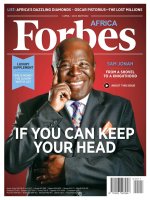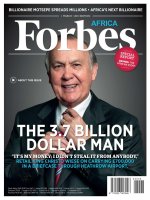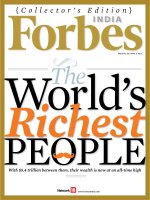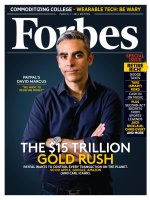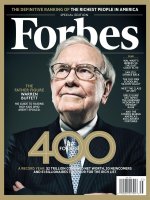Forbes USA 28 October 2013 (e-magazine full)
Bạn đang xem bản rút gọn của tài liệu. Xem và tải ngay bản đầy đủ của tài liệu tại đây (20.88 MB, 131 trang )
AMERICA’S BEST BUSINESS SCHOOLS • SILICON ALLEY’S FIRST BILLIONAIRE
-PRENE
U
ER
P
5O
BE
ST
S
NIE
PA
THE
STARTUP
SECRETS
SMALL CAPS
TO BUY NOW
REVENGE OF
WEB 1.0
RS
SU
OCTOBER 28 • 2013 EDITION
O
SMALL C
M
TWITTER CEO
DICK COSTOLO
“BROADCASTERS HAVE
COME TO UNDERSTAND
THAT WE ARE A
FORCE MULTIPLIER.”
HOW TWITTER
WILL SAVE TV
(AND TV WILL SAVE TWITTER)
THE HYPED IPO LACKS A REAL BUSINESS MODEL.
THE TELEVISION NETWORKS BLEED VIEWERS.
INSIDE THEIR PLAN TO MAKE BILLIONS TOGETHER.
What are you
thinking about?
We’re thinking about your security.
Your business pulls you in a lot of directions. Our job is to think about your
business’s security, no matter where you are. With Tyco Integrated Security’s
Mobile Security Management, you can remotely manage your security
system at any time, from anywhere, on your smart phone, tablet or laptop.
It’s just one reason why we help secure more businesses – of any size – than
any other company. We’re your Tyco Team. And we put security in the
palm of your hand.
For a free Mobile Security demo, visit TycoIS.com/mobile
1.800.2.TYCO.IS / Safer. Smarter. Tyco.™
License information available at www.tycois.com. © 2013 Tyco. All rights reserved.
Tyco is a registered trademark. Unauthorized use is strictly prohibited.
©2013 John Paul Mitchell Systems®
“Growing up, we didn’t have a lot of money, but my mother always grew her own vegetables.
Now we’re bringing generations together...helping thousands of families help themselves with
Grow Appalachia’s community gardens.”
John Paul DeJoria, CEO and Co-founder
THE BEST IN PROFESSIONAL SALON HAIR CARE PRODUCTS
Guaranteed only in salons and Paul Mitchell Schools. paulmitchell.com
contents — octoBeR 28, 2013
VoLUMe 192 nUMBeR 6
70 | king of The Second Screen
It’s prime time for Twitter CEO Dick Costolo.
108 | STarTuP School
An M.B.A. program for budding
entrepreneurs, not I-bankers.
15 | FACT & COmmEnT
by STeve forbeS
Senators: Don’t be easy on the next Fed head.
LEADERBOARD
20 | THE STATE OF BAnkinG
Pay is the only thing that grows in
good times and bad.
23 | SCORECARD
Zuckerberg wins again; Hayne unravels.
26 | CASH AnD CARRIE
Less blood is better for Stephen King movies.
Plus: FORBES Makeover
28 | EvERyTHinG’S JUST FinE
Banks rationalize their bad behavior.
Plus: Up-and-Comers
32 | ACTivE COnvERSATiOn
Bad-boy billionaire Stewart Rahr and the 399 other
members of The Forbes 400.
cover PhoTograPh by eric MilleTTe for forbeS
6 | FORBES OCTOBER 28, 2013
RE:INVEST YOUR CASH WITH A STRONG
ONE-TWO PUNCH.
Turn everyday purchases into investing opportunities.
FREE ATM ACCESS
2% CASH BACK ON EVERY PURCHASE
with the Fidelityă Cash Management debit card1
with the Fidelity American Expressă Card
ã Get automatically reimbursed for all ATM fees
• Rewards automatically deposited into your
Fidelity retirement, brokerage, or college
savings account2
• Free checkwriting and online bill pay
• Free mobile check deposit
See how we can help
your cash work harder for
your Personal Economy.
• No limits on rewards3
«««««
Fidelity.com/Cash
800.FIDELITY
Keep in mind that investing involves risk. The value of your investment will fluctuate over time and you may gain or lose money.
The Fidelity® Cash Management Account (the “Account”) is a brokerage account designed for spending and short-term investing. ATM fees are waived, and reimbursement is
provided for all ATM fees charged by other institutions when you use your Fidelity® Visa® Gold Check Card at any ATM displaying the Visa,® Plus,® or Star® logos. A 1% foreign
transaction fee is not waived and will be included in amounts debited from your Account. The Fidelity® Visa® Gold Check Card is issued by PNC Bank, N.A., and administered by
BNY Mellon Investment Servicing Trust Company.
2
For information about rates, fees, other costs, and benefits associated with the use of the credit card, or to apply, call the number or visit the Web site above and refer to the
disclosures accompanying the online credit application. Customers earn 2 points for each $1 in net retail purchases. Once you reach 5,000 points, they can be redeemed
automatically or on demand for cash at a 1% exchange rate into an eligible Fidelity account (i.e., 5,000 points = $50 deposit). The ability to contribute to an IRA or 529
college savings plan account is subject to IRS rules and specific program policies, including those on eligibility and annual and maximum contribution limits. Additional
restrictions apply. Full details appear in the Program Guidelines new card customers receive with their card. The credit card program is issued and administered by FIA Card
Services, N.A. American Express is a federally registered service mark of American Express and is used by the issuer pursuant to a license. Investment Rewards is a registered
trademark of FIA Card Services, N.A.
3
Certain restrictions apply to each benefit. Details accompany new account materials.
*SmartMoney magazine, June 2010, 2011, and 2012. Industry review ranking leading discount brokers based on ratings in the following categories: commissions and fees, mutual
funds and investment products, banking services, trading tools, research, and customer service.
Fidelity is not a bank and brokerage accounts are not FDIC insured.
Fidelity Brokerage Services LLC, Member NYSE, SIPC. © 2013 FMR LLC. All rights reserved. 646076.1.0
1
contents — octoBeR 28, 2013
THOUGHT LEADERS
82 | SurvivorS—and ThriverS
Three distant memories from the
1990s bubble light up our list of
America’s Best Small Companies.
34 | CURREnT EvEnTS
by Paul johnSon
Obama versus Putin:
Can Obama muster the right stuf?
36 | CApiTAL FLOwS
by naThan leWiS
A stable dollar delivers economic stimulus.
40 | innOvATiOn RULES
by rich karlgaard
Tara’s lesson: Smart leaders copy.
STRATEGiES
42 | DETROiT’S HAppy
HOmE wRECkER
The Pulte family made billions building homes.
Now Bill Pulte is tearing them down.
by joann Muller
46 | THE ApOTHECARy
Three key questions for ObamaCare’s rollout.
by avik roy
98 | Who needS The iPhone?
Even without Apple, InvenSense’s
gyroscope business is pointing
straight up.
TECHnOLOGy
48 | A piCTURE’S wORTH
A BiLLiOn DOLLARS
Jon Oringer turned a side project
into a $2.5 billion photo phenomenon.
by STeven berToni
54 | CHinA’S BLACk BOx
The Chinese answer to Apple TV
is full of pirated content.
by SiMon MonTlake
56 | OnE ADDRESS BOOk
TO RULE THEm ALL
Privacy experts are a little freaked out
about a startup’s self-updating
contact book.
92 | Say cheeSe
Annie’s has the right ingredients
for organic growth.
by adaM Tanner
42 | deMoliTion
Man
A home builder
turns to the
wrecking ball.
26 | Murder
doeSn’T Pay
The Stephen King
Rule: fewer bodies,
more money.
invESTinG
60 | DAy TRADinG GABELLi
ETFs may soon be emerging from
their index fund ghetto.
by ari i. Weinberg
64 | pORTFOLiO STRATEGy
by ken fiSher
Betting against Bernanke.
66 | SmALL STOCkS
by jiM oberWeiS
America’s best small stocks.
68 | yEAR-EnD CHECkUp
by WilliaM baldWin
A Roth conversion formula.
8 | FORBES OCTOBER 28, 2013
contents — octoBeR 28, 2013
BEST SmALL COmpAniES
48 | caMera Man
Oh, snap! Shutterstock’s
Jon Oringer is Gotham’s
frst tech billionaire.
82 | DARwin’S DiGiTAL DARLinGS
Some Web dinosaurs have surged back onto our list
of America’s Best Small Companies.
by naTalie robehMed
92 | miLD inDiGESTiOn
Annie’s has discovered the double-edged
phenom of innovation: new products fuel growth
and nasty competition.
by Meghan caSSerly
98 | THE CHipS ARE Up
A year after a management shakeup InvenSense is
out for a piece of Apple’s business.
by karSTen STrauSS
FEATURES
70 | CAn TwiTTER SAvE Tv? (AnD CAn
Tv SAvE TwiTTER?)
On the eve of its fervently hyped IPO, the
micromessaging service has a radical plan to nab
the ad dollars it needs to thrive: help TV networks
survive the digital media revolution.
by jeff bercovici
102 | THAT SinkinG FEELinG
Carnival has brought a new CEO on board, but
investors are headed for the lifeboats.
by caleb Melby
60 | deSigner fundS
ETFs from your favorite
mutual fund stars.
BEST BUSinESS SCHOOLS
108 | EnTREpREnEUR BOOT CAmp
Austin’s tiny Acton School has one goal: turning
battle-ready graduates into startup successes.
by Michael noer
Plus: The 25 Best Business Schools
BrandVoice
by SaMSung elecTronicS aMerica
Transforming STEm Education One
Community at a Time. 111
116 | TAkEOvER UnivERSiTy
102 | S.o.S.
Carnival’s new skipper may be on a
cruise to nowhere.
A wildly popular Stanford class encourages M.B.A.s
to take control of a real business.
by george anderS
LiFE
122 | THE vinEyARD COLLECTOR
TPG cofounder Bill Price has a plan:
produce wine you can’t buy.
by richard nalley
128 | THOUGHTS
On entrepreneurs.
122 | The good
earTh
Kistler Vineyards stars
in a private equity
prince’s second act.
10 | FORBES OCTOBER 28, 2013
Can you risk less by
reinventing more?
Three out of four new products never make it to market, which makes
some businesses shy away from being innovative. Smarter enterprises
are making trial and error a strength of their development process.
The scalable IBM SmartCloud® is a catalyst for accelerated creativity,
helping some businesses reduce costs by up to 40%.
This is Cloud on a Smarter Planet.
ibm.com/reinvent
IBM, the IBM logo, ibm.com, IBM SmartCloud, Let’s Build A Smarter Planet, Smarter Planet and the planet icon are trademarks of International Business Machines Corp., registered in many
jurisdictions worldwide. A current list of IBM trademarks is available on the Web at www.ibm.com/legal/copytrade.shtml. © International Business Machines Corporation 2013.
FORBES
IN BRIEF
EDITOR-In-CHIEF
Steve Forbes
CHIEF PRODUCT OFFICER
Lewis D’Vorkin
FORbEs MagazInE
EDITOR
Randall Lane
ExECUTIvE EDITOR
Michael Noer
aRT & DEsIgn DIRECTOR
Robert Mansfeld
FORbEs DIgITal
vP, InvEsTIng EDITOR
Matt Schifrin
ManagIng EDITORs
Dan Bigman – Business, Tom Post – Entrepreneurs, Bruce Upbin – Technology and Wealth
sEnIOR vP, PRODUCT DEvElOPMEnT anD vIDEO
Andrea Spiegel
ExECUTIvE DIRECTOR, DIgITal PROgRaMMIng sTRaTEgy
Coates Bateman
ExECUTIvE PRODUCER
Frederick E. Allen – Leadership
Tim W. Ferguson FORbEs asIa
Kerry A. Dolan, Connie Guglielmo, Kashmir Hill sIlICOn vallEy
Janet Novack WasHIngTOn
Michael K. Ozanian sPORTsMOnEy
Mark Decker, John Dobosz, Luisa Kroll, Deborah Markson-Katz DEPaRTMEnT HEaDs
John Tamny OPInIOns
Kai Falkenberg EDITORIal COUnsEl
bUsInEss
Mark Howard CHIEF REvEnUE OFFICER
Tom Davis CHIEF MaRkETIng OFFICER
Charles Yardley PUblIsHER & ManagIng DIRECTOR FORbEs EUROPE
Nina La France sEnIOR vP, COnsUMER MaRkETIng & bUsInEss DEvElOPMEnT
Miguel Forbes PREsIDEnT, WORlDWIDE DEvElOPMEnT
Jack Laschever PREsIDEnT, FORbEs COnFEREnCEs
Michael Dugan CHIEF TECHnOlOgy OFFICER
Elaine Fry sEnIOR vP, M&D, COnTInUUM
FORbEs MEDIa
Michael S. Perlis PREsIDEnT & CEO
Michael Federle CHIEF OPERaTIng OFFICER
Tom Callahan CHIEF FInanCIal OFFICER
Will Adamopoulos CEO/asIa FORbEs MEDIa
PREsIDEnT & PUblIsHER FORbEs asIa
Rich Karlgaard PUblIsHER
Moira Forbes PREsIDEnT, FORbEsWOMan
MariaRosa Cartolano gEnERal COUnsEl
Margy Loftus sEnIOR vP, HUMan REsOURCEs
Mia Carbonell sEnIOR vP, CORPORaTE COMMUnICaTIOns
FOUnDED In 1917
B.C. Forbes, Editor-in-Chief (1917-54)
Malcolm S. Forbes, Editor-in-Chief (1954-90)
James W. Michaels, Editor (1961-99)
William Baldwin, Editor (1999-2010)
Innovations Behind
Our Rising Numbers
by lEWIs D’vORkIn
It’s just a number, but it’s a big one. Last month Forbes.com
hit a record 51 million unique monthly readers as measured
by Omniture, a widely used industry reporting tool. ComScore, another measuring service, puts our worldwide audience at 26 million. By either count the number of monthly
readers has risen more than 200% from three years ago. The
FORBES model for journalism in the digital era disrupts 100
years of traditional media thinking on how to cover the news.
We have a core group of experienced, salaried reporters and
1,200 expert contributors (many part of an incentive-based
program). They’re all building individual brands and communities under the FORBES umbrella brand. Just as unique
is our BrandVoice advertising program. It ofers marketers
the same publishing tools our writers use to create content
and engage with news enthusiasts
in fresh ways. Below are just a few
key product releases that helped
spur the dramatic growth.
50
NOV. 2011
New mobile site goes live in HTML5,
optimizing Forbes for three screens
JULY 2011
Real-time stats
dashboard for
contributors
launches
30
NOV. 2010
BrandVoice
launches with
initial partner,
SAP
OCTOBER 28, 2013 — vOlumE 192 NumBER 6
FORbEs (ISSN 0015 6914) is published biweekly, except monthly in February, April, July, August and October, by Forbes LLC, 60
Fifth Ave., New York, NY 10011. Periodicals postage paid at New York, NY and at additional mailing ofces. Canadian Agreement No.
40036469. Return undeliverable Canadian addresses to APC Postal Logistics, LLC, 140 E. Union Ave, East Rutherford, NJ 07073.
Canada GST# 12576 9513 RT. POSTMASTER: Send address changes to Forbes Subscriber Service, P.O. Box 5471, Harlan, IA 51593-0971.
COnTaCT InFORMaTIOn
For subscriptions: visit www.forbesmagazine.com; write Forbes Subscriber Service, P.O. Box 5471, Harlan, IA 51593-0971;
or call 1-515-284-0693. Prices: U.S.A., one year $59.95. Canada, one year C$89.95 (includes GST). We may make a portion of
our mailing list available to reputable frms. If you prefer that we not include your name, please write Forbes Subscriber Service.
For back Issues: visit www.forbesmagazine.com; email ; or call 1-212-367-4141.
For article Reprints or Permission to use Forbes content including text, photos, illustrations, logos, and video:
visit www.forbesreprints.com; call PARS International at 1-212-221-9595; email or email
Permission to copy or republish articles can also be obtained through the Copyright Clearance Center at
www.copyright.com. Use of Forbes content without the express permission of Forbes or the copyright owner is expressly prohibited.
Copyright © 2013 Forbes LLC. All rights reserved.
Title is protected through a trademark registered with the U.S. Patent & Trademark Ofce. Printed in the U.S.A.
12 | FORBES OCTOBER 28, 2013
SEPT. 2013
Intelligent
scrolling
40
streams
MAY 2010
Forbes acquires
True/Slant
2010
JAN. 2013
FORBES
magazine app
launches
JUNE 2012
New home page,
following functionality;
1000 contributors publish
8200 posts/month
2011
2012
2013
MONTHLY UNIqUE VISITORS (IN MILLIONS)
20
10
© 2013 Citigroup Inc. Citi and Citi with Arc Design are registered service marks of Citigroup Inc. The World’s Citi is a service mark of Citigroup Inc.
THE
WORLD’S
CITI. IT’S
WHEREVER
YOU ARE.
It isn’t New York or London
or Beijing. It’s not Lagos or
São Paulo or Dubai. Today,
it’s wherever you are.
Wherever you bring your
ideas, drive, passion and
a hope that someone will
believe in you. What if a bank
made that its job? Wherever
people come together to
create or build something,
we’re there to help make
it real. For over 200 years.
Around the world.
citi.com/progress
FORBES
FACT & COMMENT — STEVE FORBES
“With all thy getting, get understanding”
SEnaTORS: dOn’T BE EaSy
On ThE nExT FEd hEad
BY STEVE FORBES, EDITOR-IN-CHIEF
When President Obama
takes time out from stonewalling
congressional Republicans over
the continuing budget resolution
and raising the debt ceiling to pick
a nominee for the next Federal
Reserve chairman, the U.S. Senate
should be prepared to ask that candidate hard, critical questions and
to reject the person if satisfactory
answers aren’t forthcoming.
To “stimulate” the economy our
central bank, at the direction of Ben Bernanke,
has undertaken unprecedented actions that
have immensely harmed credit markets, thereby
retarding recovery. They have the potential to
infict even greater damage on us and the world
than the 2008–09 crisis. Without congressional
authority the Fed has assumed enormous economic powers. Even worse, despite the Fed’s
manifest failures before and after the economic
crisis, Congress has granted it other powers that
threaten our economic future. The Fed houses
the Consumer Financial Protection Bureau,
which wields almost unbridled authority over
banks and fnance companies regarding mortgages, credit cards and other lending activities, and gives it whatever funds it wants. The
bureau has no real accountability to Congress,
which is why it can hire like crazy at a time of
supposed federal budget tightness and lay out a
reported $95 million in “ofce renovations.”
Senators, whose job it is to confrm or reject
the President’s nominee, will be highly reluctant
to do anything other than go through the motions
in the aftermath of the current circus. Republicans in particular won’t want to be accused of
“playing politics” with such a critical, sensitive
post. But this is the time for statesmanship.
Monetary policy is that peculiar
subject that intimidates most people.
It’s not because of its complexity; the
basics are simple. And, though it may
be impossible to believe these days,
there are plenty of people in Congress who can master arcane, difcult
matters. But, strangely, the psychology of monetary policy strikes anxiety
and trepidation into the hearts of
most. However, given the crucial
importance of the Fed right now, this
fear must be overcome for the sake of the country.
The nominee must be grilled hard regarding
how he/she plans to unwind the Fed’s promiscuous bond buying. The central bank’s recent
botched attempt at “tapering” demonstrates
how difcult this will be. Much of Wall Street is
addicted to the process, as stock and bond gyrations during the “tapering” fasco attest. When it
comes to bond prices, unwinding is going to be
rough. Markets try to anticipate the future, and if
traders and investors think more normal interest
rates are coming down the road, they will mark
the value of bonds down now, not gradually.
Never before in history has an important
central bank done what ours has done: loaded up
on long-term government bonds and mortgages
by borrowing short-term money from banks.
Bernanke & Co. have bought hundreds of billions
of Treasury bonds at premiums from par. That is,
they are paying, say, $1,200 for a bond that was issued at $1,000—which is what happens when you
suppress long-term interest rates. Noted economist and FORBES columnist David Malpass calculates that these premiums now exceed $200 billion
and should be added to our nation’s debt.
This raises other obvious questions for Obama’s
pick: Why shouldn’t these excesses be part of the
OCTOBER 28, 2013 FORBES
| 15
ACURA.COM / MDX
MDX with Advance Package shown. Learn more at Acura.com or by calling 1-800-To-Acura. ©2013 Acura. Acura and MDX are trademarks of Honda Motor Co., Ltd.
ADDING
BUTTONS
ISN'T
INNOVATION,
REMOVING
THEM
IS
FORBES
debt, and who gave the Fed the authority to add to the national debt without
congressional approval? The debt
ceiling was exceeded before our Treasury Department acknowledged it.
Quantitative easing upended
American credit markets, just as
rent control does with local housing
markets. QE limited the availability
of credit for nonfavored borrowers.
Under QE the federal government
fnances defcits without tears.
Washington pays barely any interest
on its new borrowings, and, thanks
to the Fed, it can borrow as much
as it wants until the debt limit is
reached—at which point Congress
always raises the ceiling.
Big companies also have easy access to credit, one reason that their
balance sheets have never been stronger. The housing market has benefted
from massive, ongoing purchases
of hundreds of billions of dollars
in mortgage-backed securities. But
smaller, job-creating businesses have
sufered because of limited access to
credit. Only recently has there been
a better fow of credit to this crucial
part of our economy, thanks, in part,
to a wonderful American characteristic—when something is blocked,
entrepreneurs fnd ways to get around
it. Numerous nonbank sources for
credit to smaller businesses, including
equity funds, are starting to fll the gap.
Who gave the Federal Reserve the
authority to allocate credit?
Another important question: Why
has one-third of the Fed’s bond-buying
since the downturn remained at the
Fed instead of being put to work in
the economy? This strange pattern
has been evident for several years.
Why hasn’t the central bank addressed this matter? One big factor is
that regulators pressured banks not
to lend except to the federal government. This was done to improve
bank balance sheets. But this caution
clearly went too far.
Now that we have this massive
overhang, what’s to prevent a return
18 | FORBES
OCTOBER 28, 2013
to 1970s-style infation?
In 2008 the Fed was given permission to pay interest on reserves. Did
this help block the fow of credit to
smaller businesses? Has the Fed conducted any studies regarding this? If
not, why not?
What real-world evidence is there
that quantitative easing here and
Vice Chairwoman of the Federal reserve
Janet Yellen, who likes an ultraweak dollar, is
favored to succeed Ben Bernanke.
elsewhere has actually stimulated
economic growth? Never before in
U.S. history has there been such a
punk recovery after a sharp downturn—and that includes the Great
Depression. A severe contraction
has always been followed by a sharp
upturn. The question then becomes
whether the upswing can be sustained. In the 1930s it could not.
When the Fed tapers again what’s
to prevent a repeat of the 1997–98 Asia
crisis? We got a taste of what could
happen with the brief tapering this
year. The anticipation of higher rates in
the U.S. led to an outfow of funds from
such emerging and middle-income
countries as Brazil, India and Indonesia
and to attacks on their currencies.
This is a vitally important issue.
Too often central banks don’t know
how to defend their currencies. The
frst thing a government must do is
announce unequivocally that it will
defend its money. Next it must raise
interest rates to underscore that
intent. Then it must aggressively buy
its currency in foreign exchange markets with its reserves, usually dollars
(other currencies, such as the euro
and yen, as well as gold, make up the
rest of a country’s reserves). Done
right, this last step will decisively end
any assault on the integrity of the
currency. However, where a central
bank too often falters is in reducing
the size of its monetary base, which
is made up of the currency in circulation and domestic bank reserves.
Here’s what happens. A central
bank buys its currency with dollars—
which is good—but it then promptly
puts that money back into its domestic economy by, most likely, buying its
government debt. What the central
bank took away with one hand has
been given back with the other; the
monetary base remains unchanged.
All that’s happened is that the central
bank has reduced its reserves—and
done it for nothing. Economists call
the process “sterilization.”
This self-defeating exercise happens time and time again. Look at
Thailand in 1997, when the economic
crisis in Asia began. Bangkok had
ample reserves, almost $40 billion. At
the time its currency, the baht, was
fxed to the dollar at roughly 25 bahts
to the dollar. When the baht began to
weaken, the Bank of Thailand should
have reduced its monetary base by
using dollars to buy bahts in foreign
exchange markets. Thailand had
enough dollars to buy its entire monetary base twice over. Instead it engaged in sterilization. It ran down its
reserves and then let the baht “foat,”
which sent it into a free fall.
One country that didn’t fall into
the sterilization trap during the
fnancial crisis of 2008–09 was Russia. When the ruble came under
assault the Bank of Russia initially
responded the conventional sterilization way. Then in early 2009, after an
op-ed piece by monetary expert and
FORBES columnist Nathan Lewis
appeared in Pravda, Russia reversed
course, reducing its monetary base.
Result: The ruble strengthened, the
speculators were routed and the crisis
ended with the ruble triumphant. F
Andrew HArrer/BloomBerg
FACT & COMMENT — STEVE FORBES
Handling $421 billion in accounts payables annually.
Made simple by Xerox.
Today’s Xerox is simplifying the way work gets done in surprising ways. Such as managing global finance, accounting and
procurement operations for customers across the entire order-to-cash life cycle. All delivered as scalable solutions designed
to help you achieve measurable process efficiencies and cost savings in both the short and the long term. It’s one more
way Xerox simplifies business, so you can focus on what really matters.
RealBusiness.com
â2013 Xerox Corporation. All rights reserved. Xeroxđ Xerox and Design® and Ready For Real Business®
,
are trademarks of Xerox Corporation in the United States and/or other countries.
LEADERBOARD
KEEPING SCORE ON WEALTH & POWER
2.150 M
2.046 MIL EMPLOYEES
$60,883 SALARY/EMPLOYEE
1.41
ROAA%
1.3
1.33
INDUSTRY ATLAS
THE STATE
OF BANKING
$65,608
2.097 M
$60,724
THANKS TO the government, U.S. banks are
back on a solid footing. Return-on-averageassets, shown in the center of each bubble,
and stock prices have rebounded impressively
since the depth of the financial crisis. But trillions in stimulus spending has done little to
revive banks’ core mission—lending money—
with the ratio of loans to deposits still falling.
The only thing that has consistently grown, in
good times and bad, is bankers’ pay, represented by the ever-expanding colored circles.
$12 Trillion
10
1,200%
100%
SNL U.S. BANK AND
THRIFT INDEX
TOTAL RETURN
GROWTH OF LOANS
AND DEPOSITS IN
U.S. BANKS AND THRIFTS
1,000
80
8
800
60
6
4
600
40
Loans (left scale)
Deposits (left scale)
Loans/deposits (right scale)
400
20
2
2003
’05
’07
’09
’11
’13
200
2003
’05
’07
’09
’11
’13
SOURCE: SNL FINANCIAL.
2003
20 | FORBES OCTOBER 28, 2013
2004
2005
2006
1.5
COMPENSATION PER
BANK EMPLOYEE
2.205 M
+90K
1.37
80–90K
$91,694
70–80K
$68,987
60–70K
1.2
2.213 M
$87,893
1.11
$72,282
1.02
$84,217
.94
0.9
.91
2.097 M
2.108 M
$80,971
2.089 M
2.108 M
.65
0.6
2.150 M
0.3
$72,434
.13
$79,767
2009
2007
2008
2010
-.10
0
2011
2.061 M
2012
2013
OCTOBER 28, 2013 FORBES | 21
Answering 1.6 million customer interactions a day.
Made simple by Xerox.
Today’s Xerox is simplifying the way work gets done in surprising ways. Such as helping companies manage
their customer care operations, help desks and online support. Giving you access to timely, scalable and
cost-effective call center solutions in any language, anywhere around the world. It’s one more way Xerox
simplifies business, so you can focus on what really matters.
RealBusiness.com
©2013 Xerox Corporation. All rights reserved. Xerox® Xerox and Design® and Ready For Real Business®
,
are trademarks of Xerox Corporation in the United States and/or other countries.
LEADERBOARD
$53 MILLION
The civil penalty Ty Warner must pay
in his federal tax-evasion case.
SCoRECARD
WINNERS
Mark
Zuckerberg
Jef
Bezos
Phil
Knight
scorecard by scoTT decarLo; new biLLionaires by aLex morreLL
ZUCKerberg: ANDrew hArrer/bloomberg; beZoS: t.J. KirKpAtriCK/bloomberg; AriSoN: JohN pArrA/getty imAgeS; hAyNe: george wiDmAN/Ap; wArNer: ChriS hoNDroS/getty imAgeS
+$4.7 billion
+$2.6 billion
+$1.3 billion
Net worth:
$23.5 billioN
Net worth:
$29.8 billioN
Net worth:
$17.7 billioN
As wall Street’s infatuation
with Facebook continues
and the stock keeps rising,
Zuckerberg makes his
fourth straight appearance
as a big gainer.
Amazon trades at an
alltime high as it introduces
three new Kindle Fire
models, while its founder
ofcially takes control of
the Washington Post.
Nike’s stock soars after
the company posts
impressive quarterly
earnings and is made
part of the Dow Jones
industrial average.
nEW billionAiRE
LOSERS
Micky
Arison
INSYS’
JOHN KAPOOR
Richard
Hayne
Ty
Warner
–$560 million
–$180 million
Guilty
Net worth:
$5.3 billioN
Net worth:
$1.6 billioN
Net worth:
$2.7 billioN
his holdings in Carnival,
the world’s largest cruise
company, tank with lower
quarterly earnings and
weak bookings—see “that
Sinking Feeling,” p. 102.
Urban outftters, which
he cofounded in 1970,
falls 10% in a day after the
company reports weak
sales and fails to meet
analysts’ forecasts.
the beanie babies founder
faces up to fve years in
prison after pleading guilty
to federal tax evasion for
hiding millions of dollars in
a Swiss bank account.
stock of his pharmaceutical company,
Insys Therapeutics, has quintupled since
its May IPO, catapulting him to billionaireship at 70. Insys produces drugs to alleviate
cancer patients’ symptoms; he’s its founder
and executive chairman, and his stake is
now worth more than $600 million. He also
owns more than $400 million of drugmaker
Akorn. The frst member of his family to go
to college, he arrived in America from India
in 1964. His career took of when he joined
LyphoMed, a struggling pharma company, in
1978, worked his way up to general manager,
turned the business around and sold his
share of it in 1990 to net $100 million. He has
been a serial entrepreneur ever since. “This
is the country you can do it in. Nowhere
else,” he tells FORBES.
FigUreS reFleCt the ChANge iN VAlUe oF pUbliCly trADeD holDiNgS From AUg. 23 to oCt. 2.
SourceS: InteractIve Data vIa FactSet reSearch SyStemS; ForbeS.
october 28, 2013 ForbeS | 23

